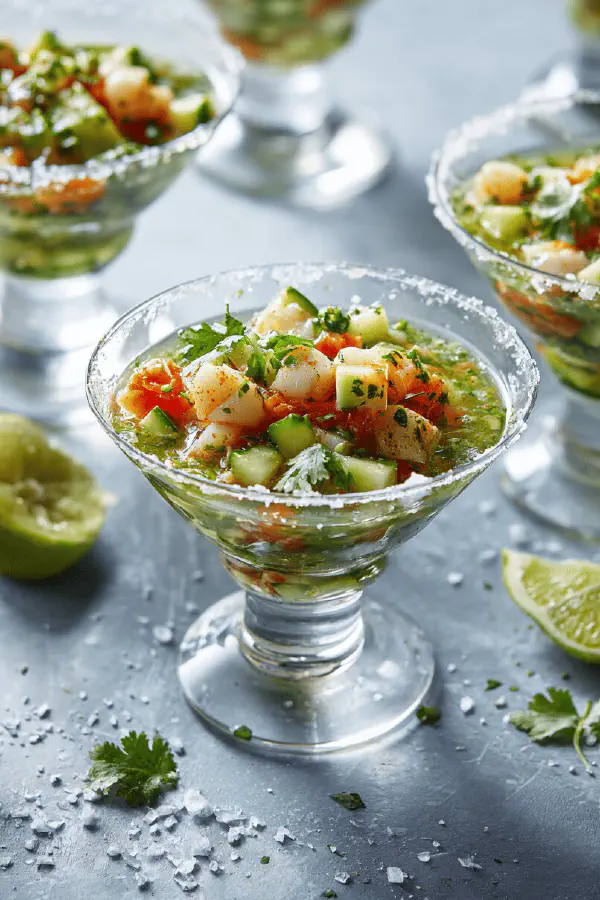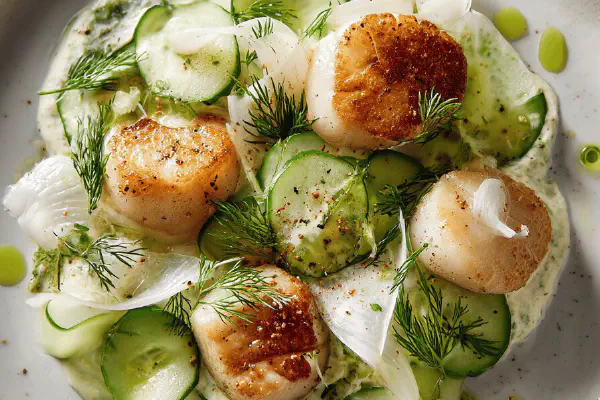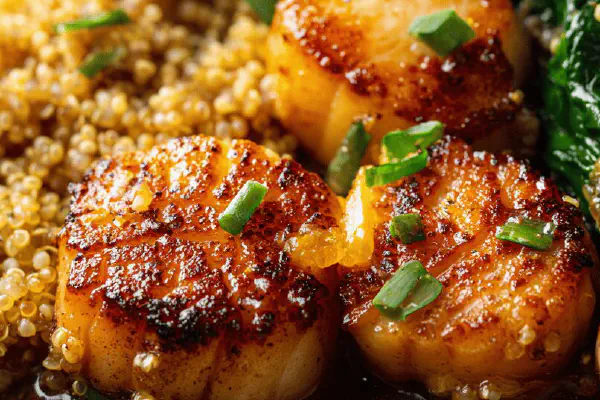Featured Recipe
Scallop Ceviche Twist

By Kate
"
Fresh diced scallops mixed with diced fire-roasted tomatoes and zucchini for a twist. Lime zest and juice provide brightness, balanced by avocado oil and fresh cilantro. Salt-crusted glass rims add sharp citrus contrast. No eggs, nuts, gluten, dairy, or lactose. Serve in margarita glasses for that festive vibe. Resting time allows flavors to meld without over-marinating. Quick, visual cues for texture critical. Simple, clean, stripped of fluff.
"
Prep:
20 min
Cook:
0 min
Total:
20 min
Serves:
4 servings
scallops
ceviche
seafood
Latin American
Introduction
Scallop ceviche done right demands respect to timing, texture, and acidity. Not just throwing ingredients into acid and hoping. Scallops must be diced just so—not mush, not chunky. Acid cooks surface proteins fast. Too long? Rubber siding. Too short? Raw mush. Fire-roasted tomatoes add necessary smoky depth replacing regular raw—keeps it vibrant but adds umami. Zucchini swaps cucumber because it holds shape better—avoid watery mix that dilutes sharp citrus. Lime zest plus juice layers flavor dynamic. Avocado oil lends creaminess without overbearing olive oil bitterness. Salt on glass rims isn’t for show. Citrus oil and salt together punch nose and first sip. Resting time crucial. Peaks at precisely opaque scallop edges and freshness in veggies. Play with it—don’t just watch clock.
Ingredients
About the ingredients
Quantity adjustments important. Cut scallops down 25% to keep every bite firm and manageable when diced. Fire-roasted tomatoes chosen for their smoky aroma—buy canned or roast fresh; skin and seeds removed to avoid bitterness and extra liquid. Zucchini swapped in avoids soggy texture common with cucumber and controls water release. Avocado oil preferred to olive oil due to milder taste and higher smoke point, handling warm kitchen better. Cilantro fresh and finely chopped gives herbal contrast; stems add bitter notes, so strip leaves clean. Salt application on glass rims tightens citrus impact; coarse sea salt works best, avoids clumping. Lime wedges serve dual purpose: glass preparation and bonus zest squeeze. Use freshest scallops available; any sign of fishy odor means skip. If scallops unavailable, firm white fish like halibut or mahi-mahi possible but texture and timing differ—watch carefully.
Method
Technique Tips
Start chopping scallops first; texture dictates success. Overmincing equals glue-like ceviche; keep pieces about 1 cm chunks. Remove tomato seeds fully to stop watery puddle forming—pulp can water down acid’s punch. Mixing order? Always acid with seafood immediately so proteins coagulate evenly—not banging in acid 10 minutes later after all else. Rest time—opt for 7-10 minutes, no more. Visual cue: scallop edges turn from translucent to opaque with slight firmness. If you smell ammonia, stop; scallops gone bad. Prepping rims last—lime oils activate salt adhesion. Avoid soaking glasses or wet rims; dehydrate with towel if needed before salting. Serve fast—ceviche continues to ‘cook’ and may become rubbery if left out. Leftover? Keep refrigerated, but texture deteriorates within hours. Always taste final seasoning; acid tempers salt but over-salting hard to fix after. Balance acid, salt, and oil to taste, not just following measurement blindly.
Chef's Notes
- 💡 Chop scallops about 1 cm chunks. Texture is crucial. Too fine, it becomes mush. Too large means uneven cooking. Visual cues matter.
- 💡 Fire-roasted tomatoes bring depth. Regular ones dilute flavor. Remove seeds; they add unnecessary liquid. Uniform dice size—necessary for even mixing.
- 💡 Zucchini swaps cucumber. Less water—prevents mush. Adds nice crunch. Cut into small pieces for proper blending and vibrant look. Preserve texture.
- 💡 Rest ceviche 7-10 minutes. Scallop edges should turn opaque, giving firmness. Too long, mushy texture; too short, raw. Timing is key.
- 💡 Prep glass rims last. Rub lime first to help salt stick. Coarse salt gives desired saltiness; avoids clumping. Make sure rims are dry.
Kitchen Wisdom
Best way to choose scallops?
Freshness is key; no fishy smell. Look for translucent, firm texture. Bad scallops go limp, shiny.
What's the deal with resting?
It allows flavors to blend. Too much time can lead to mush, timing is essential. Stay vigilant.
How to store leftovers?
Keep in airtight container over ice pack. Changes happen quickly; texture falls apart. Better fresh.
Alternatives for scallops?
Firm white fish like halibut works in a pinch. Watch cooking times and textures; adjust as needed.



